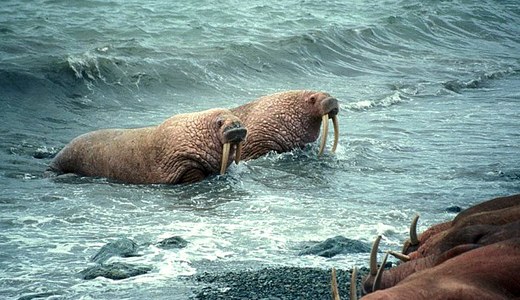
As global warming threatens the wellbeing of Alaskan walruses, the government has exacerbated the issue. The Department of Interior has approved an Arctic drilling program by Royal Dutch Shell, allowing the company to potentially drill into four shallow water wells beginning in the summer of 2012, Reuters reported.
The area Shell is eyeing is the Beaufort Sea, located off the North Slope of Alaska.
According to the Environmental News Network, the initial ongoing problem at hand is thus:
With climate change causing Arctic sea ice to melt, desperate walruses in the Chukchi Sea have been heaving themselves onto shore, causing them to become – in rapid numbers – more vulnerable. As a result, they are frequently crushed to death by stampedes, or attacked by predators, putting them at severe risk.
Rebecca Noblin, Alaska director of the Center for Biological Diversity, said the Department of Interior declared that no further assessment was needed on the impacts drilling could have on Arctic wildlife, the report continued.
“It’s a painful irony,” said Noblin, “that on the very day [they said this], distressed walruses were seen hauling themselves onto shore because there’s no ice where they need it. The Arctic is reeling from climate change, but the Obama administration has a head-in-the-sand approach to looking at the impacts of oil drilling in the region.”
The risks oil drilling poses to these walruses not withstanding, environmental groups also argue that tampering with the Arctic’s sensitive ecosystem in order to access its vast oil reserves could have unthinkable consequences, Reuters noted.
One silver lining, however, in this looming cloud of environmental uncertainty, is the fact that the approval of Shell’s plan is conditional – Shell must also receive permits from other agencies, such as the Environmental Protection Agency and the U.S. Fish and Wildlife Service.
Environmentalists’ concerns are not without legitimacy, though; on August 10, the UK saw the worst oil spill in its waters in a decade, thanks to the Shell company. The leak stemmed from a faulty pipeline in the North Sea, and persisted for about 10 days before Shell was able to stop it, reported the Guardian.
In a post-BP oil spill world, oil companies’ “black gold rush” is surely not to be taken lightly, nor are the worries regarding it unwarranted.
A report by the LA Times conducted a crucial examination of the worst-case scenario – should an oil spill occur in the Arctic, what would the aftermath look like? It noted that cleaning up a spill in the Beaufort Sea would be quite difficult.
Between July and October, when drilling mostly takes place, ice-free open water occurs only 54 to 88 percent of the time. What this means is that little to no cleanup measures are really possible about 20 percent of the time in June, 40 percent in August, and 65 percent of the time in October. These figures were part of a report prepared for the National Energy Board by S.L. Ross Environmental Research, a consulting firm that specializes in oil spills.
In short, what this suggests is that, in all probability, neither the government nor Shell really have adequate means of dealing with an oil spill in this region.
Meanwhile, Vicky Wyatt, senior oil campaigner for Greenpeace, remarked, “While we’ll be keeping a careful eye on whether the leak [in the North Sea] really is plugged as Shell claims, it’s obvious that the more we learn about what is supposed to be a gold standard operation, the more you worry whether Shell can be trusted to drill in the remote and fragile Arctic.”
Even if an oil spill does not occur in the Arctic, all is not necessarily well, some sources feel.
According to the LA Times, while not entirely knocking offshore drilling, Interior Secretary Ken Salazar commented, “[While] there is significant potential for oil and gas development in U.S. Arctic waters, this is a frontier with harsh weather conditions, as well as unique fish and wildlife resources that Alaska’s indigenous people rely on for subsistence.
“To make responsible decisions, we need to understand the environmental and social consequences.”
As for the walruses, in addition to having a potential BP-esque disaster headed their way someday, the Department of Interior said, not in so many words, that the animals, while at risk, will have to wait to make it onto the Endangered Species List. Instead, the Department has placed it on the “warranted but not precluded” list, Nature News Blog reported. Of course, had the walrus indeed been placed on the Endangered Species List, it would have put quite a hiccup in Shell’s offshore drilling project.
Noblin added, in a press release for Biological Diversity, “If the Obama administration had a rational energy policy that actually addressed the threat of global warming, it wouldn’t be green-lighting risky oil development in the Arctic, which not only places a sensitive ecosystem at risk, but will also further our addiction to fossil fuels.”
Photo: A pair of walruses. Due to climate change, walruses are being forced on shore at increasing rates, where they fall victim to predation. In the midst of this, Shell intends to inadverdantly disturb their environment further via offshore oil drilling. U.S. Fish and Wildlife Service/Wikipedia










